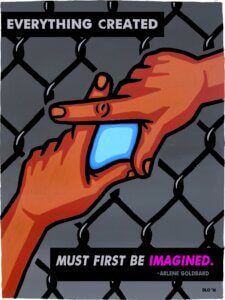Consulting | May 10, 2023
Guest Blog Author: Susan Loucks (Principal, Susan Loucks Consulting | Member, PANO’s Consultant Collaborative | Connect on LinkedIn)
Deep gratitude for:
——————————————————————————————————————————————

Graphic representation of Arlene Goldbard’s quote “Everything created must first be imagined.” by muralist, writer, and printmaker Dave Loewenstein. Image courtesy of JustSeeds.org.
I’ve spent the last year voyaging – at least metaphorically – with organizations that have re-thought important assumptions many of us bring to nonprofit structure and management. It’s been a hopeful and inspiring journey. As many of us wrestle with what seem like intractable social problems and our own ability to answer them, who wouldn’t be heartened to know that there are groups that are succeeding at doing things very differently?
The common theme in these organizations is how they’re making decisions – what we understand as governance, although in most cases they are expanding our typical picture of governance (not just something that happens in the boardroom!). They started from frustrations many of us share and used wider access to decision-making to answer them.
Some common challenges in the nonprofit context are below, along with a description of how that difference shows up in the approach these organizations took. In some cases, it’s possible to access more substantive information about the organization’s ideas (I’ve included some representative links) and in other cases stories were shared by staff in a presentation or discussion without additional reference material. None of these groups is perfect, nor does the information below reflect the richness of their choices and contexts. However, they help us recognize unnecessary boundaries in our own thinking. What could happen if we go beyond them?
Sound intriguing? The good news is that moving away from limiting assumptions doesn’t have to be all-or-nothing. Organizations can pilot ideas that make the most sense – for example, testing new methods for decisions that are transparent, efficient, and involve everyone. They can also shore up foundations in preparation for more significant change. They can discuss the way that power currently flows in their organizations and build a shared understanding of what values they want to live out in the future. They can also build capacity and mechanisms for rich and regular feedback and conflict resolution – critical for any of these possibilities to take root.
They can also locate support! Most of these organizations used consultants to contribute expertise, serve as a neutral facilitator and process designer, and/or project-manage some of the additional work of change. Could your organization benefit from the support, guidance, and expertise of an experienced consultant in considering your own best possibilities?
This guest blog post was authored by a member of PANO’s Consultant Collaborative. Susan Loucks, Principal of Susan Loucks Consulting, works with organizations that are interested in creating as good a world on the inside of their organizations as they are striving to build on the outside. Click here to learn more about Susan and click here to learn how the Consultant Collaborative can help take your mission to the next level!
Category
Related Posts
Need some nonprofit help?
Become a PANO member today.